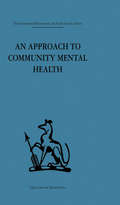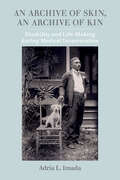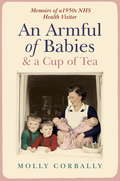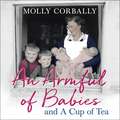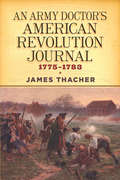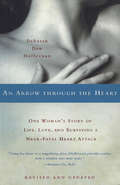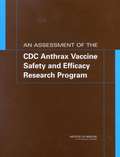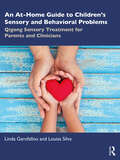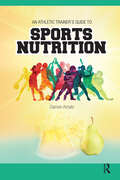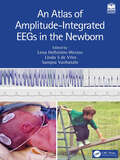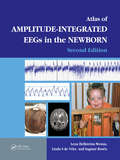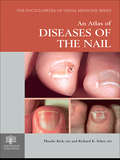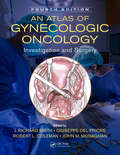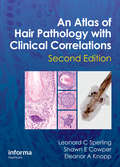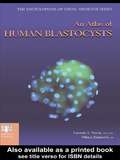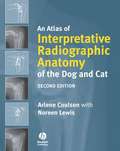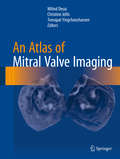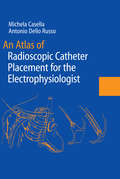- Table View
- List View
An Approach To The Psychology of Religion (International Library Of Psychology Ser. #Vol. 33)
by Cyril J. FlowerFirst published in 1999. Routledge is an imprint of Taylor & Francis, an informa company.
An Approach to Community Mental Health
by Gerald CaplanTavistock Press was established as a co-operative venture between the Tavistock Institute and Routledge & Kegan Paul (RKP) in the 1950s to produce a series of major contributions across the social sciences. This volume is part of a 2001 reissue of a selection of those important works which have since gone out of print, or are difficult to locate. Published by Routledge, 112 volumes in total are being brought together under the name The International Behavioural and Social Sciences Library: Classics from the Tavistock Press. Reproduced here in facsimile, this volume was originally published in 1961 and is available individually. The collection is also available in a number of themed mini-sets of between 5 and 13 volumes, or as a complete collection.
An Archive of Skin, An Archive of Kin: Disability and Life-Making during Medical Incarceration (American Crossroads #62)
by Adria L. ImadaWhat was the longest and harshest medical quarantine in modern history, and how did people survive it? In Hawaiʻi beginning in 1866, men, women, and children suspected of having leprosy were removed from their families. Most were sentenced over the next century to lifelong exile at an isolated settlement. Thousands of photographs taken of their skin provided forceful, if conflicting, evidence of disease and disability for colonial health agents. And yet among these exiled people, a competing knowledge system of kinship and collectivity emerged during their incarceration. This book shows how they pieced together their own intimate archives of care and companionship through unanticipated adaptations of photography.
An Armful of Babies and a Cup of Tea: Memoirs of a 1950s Health Visitor
by Molly CorballyFor all fans of Call the Midwife - a touching memoir of a young health visitor in postwar England.After serving as a nurse in WW2, Molly Corbally joined the brand new NHS and became one of the first official District Health Visitors, attending to mothers and babies from all walks of life in the picturesque village near Coventry she came to call home. Social work was uncharted territory at the time, and Britain was very much worse for wear - TB, polio, measles and whooping cough were just some of the hazards new babies faced. Social conditions could also add to the problems, at a time when poverty and alcoholism were rife. Armed with only her nursing training, her common sense and a desire to serve, Molly set out to win over a community and provide a new and valuable service in times of great change. As well as the challenges there was also joy and laughter, from the woman who finally had a baby after fifteen years of trying, to the woman who thought she should use marmalade as nappy cream, because the hospital had never taken the label off the jar they were using to store it.Warm, witty and moving, An Armful of Babies is a vivid portrait of rural England in the post-war years, and a testament to an NHS in its own infancy and to what hasn't changed: the bond between parents and their children, and the importance of protecting that.
An Armful of Babies and a Cup of Tea: Memoirs of a 1950s NHS Health Visitor
by Molly CorballyA touching and warm-hearted memoir of a young health visitor in postwar England, for fans of Call the Midwife and The Language of Kindness.After serving as a nurse in WW2, Molly Corbally joined the brand new NHS and became one of the first official District Health Visitors, attending to mothers and babies from all walks of life in the picturesque village near Coventry she came to call home. Social work was uncharted territory at the time, and Britain was very much worse for wear - TB, polio, measles and whooping cough were just some of the hazards new babies faced. Social conditions could also add to the problems, at a time when poverty and alcoholism were rife. Armed with only her nursing training, her common sense and a desire to serve, Molly set out to win over a community and provide a new and valuable service in times of great change. As well as the challenges there was also joy and laughter, from the woman who finally had a baby after fifteen years of trying, to the woman who thought she should use marmalade as nappy cream, because the hospital had never taken the label off the jar they were using to store it.Warm, witty and moving, An Armful of Babies is a vivid portrait of rural England in the post-war years, a testament to an NHS in its own infancy and a celebration of nurses and midwives. Their tireless care saves lives, and we need them now more than ever.
An Armful of Babies and a Cup of Tea: Memoirs of a 1950s NHS Health Visitor
by Molly CorballyFor all fans of Call the Midwife - a touching memoir of a young health visitor in postwar England (from the 1940s to the 1970s). After serving as a nurse in WW2, Molly Corbally joined the brand new NHS and became one of the first official District Health Visitors, attending to mothers and babies from all walks of life in the picturesque village near Coventry she came to call home. Social work was uncharted territory at the time, and Britain was very much worse for wear - TB, polio, measles and whooping cough were just some of the hazards new babies faced. Social conditions could also add to the problems, when poverty and alcoholism were rife. Armed with only her nursing training, her common sense and a desire to serve, Molly set out to win over a community and provide a new and valuable service in times of great change. As well as the challenges there was also joy and laughter, from the woman who finally had a baby after fifteen years of trying, to the woman who thought she should use marmalade as nappy cream, because the hospital had never taken the label off the jar they were using to store it.Warm, witty and moving, An Armful of Babies is a vivid portrait of rural England in the post-war years, and a testament to an NHS in its own infancy and to what hasn't changed: the bond between parents and their children, and the importance of protecting that.(P)2018 Hodder & Stoughton Limited
An Army Doctor's American Revolution Journal, 1775–1783 (Dover Military History, Weapons, Armor)
by James ThacherAt the age of 21, James Thacher (1754–1844) joined the newly formed American army as a surgeon's mate, eventually advancing to the role of surgeon for the Massachusetts 16th Regiment. In 1823, he published his Journal, reporting both wartime events he witnessed and those he heard about during his service. One of the most valuable and entertaining accounts to have survived the Revolution, Thacher's diary vividly conveys the tumultuous spirit of the era.Thacher's eyewitness reports include the siege of Boston, the hanging of British major John André, and the momentous defeats of the British Army at Saratoga and Yorktown. His direct and vivid observations range from parties where he and his fellow officers were handsomely entertained by supporters of the new nation's army to hardscrabble days when there was little to eat and nowhere to keep warm. With its cogent overview of the war's major campaigns and battles, its insights into the character of Revolutionary leaders, and its firsthand views of the daily life of a Continental Army officer, the Journal provides a heightened sense of the drama and excitement of the Revolution.
An Arrow Through the Heart
by Deborah Daw HeffernanIn the words of Mehmet Oz, MD: "An Arrow Through the Heart is an epiphany for women who mistakenly believe that they are immune from the ravages of heart disease. Using her heart as a magnifying glass, Deborah Daw Heffernan provides readers with a window into their souls." This groundbreaking memoir was first mentioned on Oprah Winfrey's life-saving 2002 show announcing cardiovascular disease as a leading cause of death among young women. That tragic fact is still true. With both depth and humor, Deborah Daw Heffernan recounts her first year of recovery from the massive heart attack that ambushed her in a gentle yoga class--during the prime of her life and despite her impeccable health history. Ranging from high-stakes action in the OR at Massachusetts General Hospital in Boston to quietly unfolding seasons on a lake in Maine, An Arrow Through the Heart is a moving and informative story of what it takes to find one's own path to true healing. Ultimately, Heffernan combines allopathic and complementary medicine to create a sensible recovery strategy for our times. She touchingly describes her husband's devotion and the toll that her cardiovascular disease takes on him, as well as how he, too, grew from the experience. Weaving their story with the lives of family and friends, Heffernan demonstrates how illness can be transformative for all involved. Not only an empowering companion for cardiac patients, this medical classic is a guide to recovery from catastrophic change of any kind. Above all, it is a powerful testament to the unexpected joy that can come from leading a life of acknowledged impermanence. Updates include cardiovascular data for today's reader, links to the author's website and other resources, a new section on SCAD (spontaneous coronary artery dissection), and-- spoiler alert--a heart transplant in 2006. All author's proceeds are donated to cardiac causes. Deborah Daw Heffernan is a graduate of Georgetown and Harvard Universities. She has worked as a teacher in Switzerland, an associate dean at Boston University, and a freelance writer. For fourteen years she was vice president of a leading Boston-based corporate training/consulting firm--until a near-fatal heart attack changed her life forever. She lives with her husband, Jack, on a small lake in Maine.
An Assessment Of The Sbir Program At The National Institutes Of Health
by National Research Council of the National AcademiesThe SBIR program allocates 2.5 percent of 11 federal agencies' extramural R&D budgets to fund R&D projects by small businesses, providing approximately $2 billion annually in competitive awards. At the request of Congress the National Academies conducted a comprehensive study of how the SBIR program has stimulated technological innovation and used small businesses to meet federal research and development needs. Drawing substantially on new data collection, this book examines the SBIR program at the National Institutes of Health and makes recommendations for improvements. Separate reports will assess the SBIR program at DOD, NSF, DOE, and NASA, respectively, along with a comprehensive report on the entire program.
An Assessment of the CDC Anthrax Vaccine Safety and Efficacy Research Program
by Committee to Review the CDC Anthrax Vaccine Safety Efficacy Research ProgramIn 1998, the Department of Defense (DoD) began a program of mandatory immunization against anthrax for all military personnel. As the program proceeded, however, some military personnel and their families raised concerns about the safety and efficacy of the anthrax vaccine. Acknowledging both the need to protect military personnel and the concerns about the anthrax vaccine, Congress directed the Centers for Disease Control and Prevention (CDC) to carry out a research program on its safety and efficacy. To assist in the development of this program, CDC requested the Institute of Medicine to convene a committee to review the completeness and appropriateness of the research program. "In An Assessment of the CDC Anthrax Vaccine Safety and Efficacy Research Program, the committee makes an overall assessment of the CDC research plan and reviews the specific studies proposed by CDC in the three areas of efficacy, safety, and acceptability. The committee also notes additional research needs that became evident following the bioterrorist events of 2001 and makes recommendations about the leadership of the research program.
An At-Home Guide to Children’s Sensory and Behavioral Problems: Qigong Sensory Treatment for Parents and Clinicians
by Louisa Silva Linda GarofallouAn At-Home Guide to Children’s Sensory and Behavioral Problems gives a new perspective on sensory and behavior problems, one that sees those behaviors as stemming from a child’s immature sensory nervous system and regulation difficulties. This book offers an effective at-home intervention, the Qigong Sensory Treatment, that enlists a parent's attuned touch to address often overlooked sensory issues that underlie ‘problem’ behaviors and works to organize those sensory experiences to foster connection and the capacity for self-regulation. It introduces the reader to a new and clinically useful model to understand sensory development, the Early Childhood Self-regulatory Milestones which are critical to the emotional and behavioral health and regulation for all children. With clear step-by-step instructions, diagrams, and links to online instructional videos, it teaches parents how to successfully implement the daily QST hands-on routine. Unique to the treatment model is how it guides and focuses parents to easily recognize, interpret and respond to their child's shifting non-verbal body and behavioral responses and cues. An extensive workbook section navigates parents through a year-long process of learning and implementing QST at home. Weekly letters include those written by the authors, parents who share their own personal experiences with the routine and by QST Master Trainers who offer their years of experience and helpful tips. The 52 letters are timed to anticipate and answer typical questions or stumbling blocks that parents commonly encounter at key points, guiding them to success with their child’s sensory and behavior difficulties while making for happier and less-stressful times with their child. This guide will be indispensable to parents and clinicians looking to understand and more effectively work with their child’s developmental difficulties.
An Athletic Trainers’ Guide to Sports Nutrition
by Damon AmatoAn Athletic Trainer’s Guide to Sports Nutrition fills the void of a subject area that is underrepresented in current athletic trainer curriculums despite its importance in the field. Damon Amato has created a text that can be easily read and understood by health care professionals yet is in-depth enough to create a solid understanding of how the body works, and easy enough to then pass on the information to athletes to help them eat ideally based on their specific sport, goal, and situation. Giving a physiology background is necessary to lay the foundation for understanding why certain recommendations in the text are given; however, only the necessary details are included to focus on what is pertinent for athletic trainers to understand while advising athletes.Some topics covered inside include: Basics of human nutrition Disordered eating and eating disorders in athletes Supplements Eating optimally for injury recovery Nutrient timing Special situations An Athletic Trainer’s Guide to Sports Nutrition gives athletic training clinicians and students the information and tools necessary to aid athletes in maintaining peak performance in nutrition, and fills the void left in the current athletic training curriculum.
An Atlas and Manual of Coronary Intravascular Ultrasound Imaging
by Paul SchoenhagenIntravascular ultrasound (IVUS) is an imaging technique used during coronary angiography. This book provides a systematic introduction to coronary imaging with (IVUS). It is divided into two integrated and extensively cross-referenced parts, the Atlas and the Manual. The Manual describes the rationale, method, and interpretation of IVUS imaging for
An Atlas for Staging Mammalian and Chick Embryos
by H. ButlerFor the convenience of research workers, particularly those with limited knowledge of embryology, we have put together a series of tables to enable rapid identification of specific stages of embryonic development in the more commonly used mammals. Because if its frequent usage the chick embryo is included this atlas.
An Atlas of Amplitude-Integrated EEGs in the Newborn
by Lena Hellström-Westas Linda S de Vries Sampsa Vanhatalo Sonia L Bonifacio Mohamed El-Dib Kathi Salley Randall Geraldine BoylanThis new edition updates the definitive clinical atlas textbook on interpreting continuous amplitude-integrated electroencephalography monitoring in neonatal units. It presents a comprehensive instructive overview linking tracings, scans, neuroimaging, real-time tracing clips, and detailed clinical scenarios and is an invaluable guide to all those needing to learn how to use aEEG for the best and safest results. An online quiz is available to enhance training and performance.This third edition of the aEEG atlas summarizes the experience and evidence of more than 40 years of aEEG monitoring in the newborn and also addresses the development and future of brain monitoring.
An Atlas of Amplitude-Integrated EEGs in the Newborn
by Lena Hellström-Westas Linda S. De Vries Ingmar RosenThoroughly revised from analogue examples to digital examples using simultaneous dual channel EEG, An Atlas of Amplitude-Integrated EEGs in the Newborn is the definitive clinical atlas-textbook on interpreting Cerebral Function Monitor (CFM) tracings. This simplified method of continuous amplitude-integrated EEG (EEG) mo
An Atlas of Atopic Eczema
by Lionel FryAtopic eczema is the most common and persistent dermatological condition seen in general practice. Over the last few years, advances have been made in the genetics of atopy in general, newer treatments have been introduced for topical use, and new concepts suggested in the etiology. Thus, a new text on atopic eczema is both timely and useful. Writt
An Atlas of Diseases of the Nail (The\encyclopedia Of Visual Medicine Ser.)
by Richard K. Scher Phoebe RichDiseases of the nail represent a surprisingly large section of most dermatologists' practice - and can present difficult, sometimes intractable, clinical problems. Co-authored by one of the world's foremost authorities in the field, An Atlas of Diseases of the Nail provides expert and authoritative guidance on all aspects of diagnosis and managemen
An Atlas of Gynecologic Oncology: Investigation and Surgery, Fourth Edition
by Robert Coleman John Monaghan J. Smith Giuseppe PrioreThe latest edition of An Atlas of Gynecologic Oncology continues its coverage of the innovative techniques in investigation and surgery on the brink of becoming established as part of the gynecologic surgeon’s repertoire, now including the exciting developments in uterine transplantation.
An Atlas of Hair Pathology with Clinical Correlations
by Leonard C Sperling Shawn E. Cowper Eleanor A. KnoppDiagnosing and treating hair disorders is still a subject that is rarely or only superficially covered in residency training. Hence, dermatopathologists and clinical dermatologists often find a gap in their knowledge. A new edition of an acclaimed text, An Atlas of Hair Pathology with Clinical Correlations, Second Edition bridges this gap and serve
An Atlas of Human Blastocysts
by Lucinda L. Veeck Nikica ZaninovicProviding information from the cutting edge of reproductive technology, this full-color atlas vividly illustrates the typical and atypical morphology of human blastocysts collected and cultured during the course of in vitro fertilization treatments. The narrative and the illustrations detail a variety of new reproductive technologies. All photographs are supported by detailed legends and a glossary of terms is included. This atlas is edited by two world-class embryologists both of whom work at the Center for Reproductive Medicine and Infertility at the Weill Medical College of Cornell University.
An Atlas of Interpretative Radiographic Anatomy of the Dog and Cat
by Arlene CoulsonThis is the definitive reference for the small animal practitioner to normal radiographic anatomy of the cat and dog. With over forty years of experience between them, the authors have produced an invaluable reference atlas for the veterinary practitioner. The book is suitable for the general and referral based practitioner, undergraduate or postgraduate veterinary surgeon. Over 550 radiographic images analysed and explained More than 50 new figures added, with the quality of existing images enhanced Revised contents and page headers for easy-reference Clear informative line drawings to trace radiographic shadows and schematic drawings of underlying structures not seen in plain radiographs.
An Atlas of Mitral Valve Imaging
by Milind Desai Christine Jellis Teerapat YingchoncharoenValvular heart medicine revolves around the need to accurately identify locations of pathological structures and/or the interventional tools needed to manage that pathology. The imaging of the valves is developing at an enormous pace and the clinician must be aware of the advantages of each modality and how it compares to the others available. There is a need for a practical, clinical atlas designed to work the reader through cases and assessing the gold standard choices available to physicians. This atlas will represent the full multimodality imaging decisions needed when assessing mitral valvular disorders. Within this atlas the authors will be presenting a comprehensive pictorial overview of the highly complex pathology/treatment techniques and management in this diverse group of patients with varied mitral valvular pathologies. Imaging modalities move fast representing challenge to practitioners. This atlas will enable them to learn the choices available and be well versed in techniques. It will therefore be essential reading for all cardiac imagers, surgeons, interventionalists, anesthetists and trainees in these disciplines.
An Atlas of Osteoporosis
by John C. Stevenson Michael S. MarshThe Third edition of this successful Atlas of Osteoporosis is designed to provide a wide range of physicians with a pictorial guide to this important disease. The illustrations are an excellent teaching resource and the text provides a concise overview to osteoporosis. For the first time, text and illustrations are fully integrated.The book con
An Atlas of Radioscopic Catheter Placement for the Electrophysiologist
by Andrea Natale Michela Casella Antonio Dello Russo P. Della BellaAn Atlas of Radioscopic Catheter Placement is unique, and has been conceived as a handy reference guide for students, interventional cardiologists, nurses and electrophysiology technicians. It includes plenty of schemes and X-ray images, and every EP correct catheter positioning is explained step by step through detailed descriptions of the necessary manoeuvres, including some "trucks" brought about by the experience.

